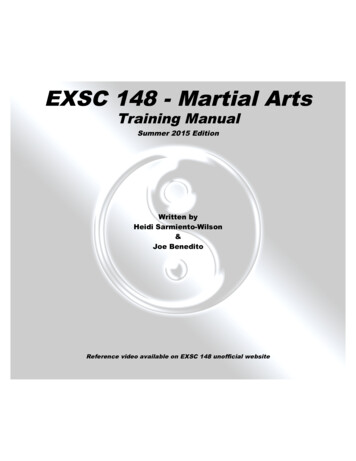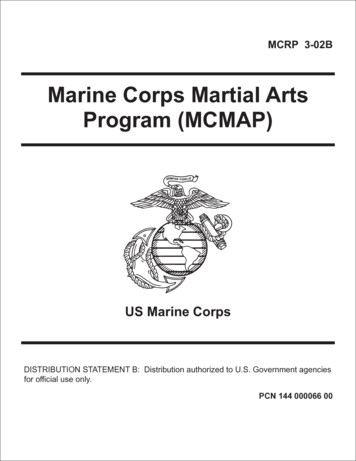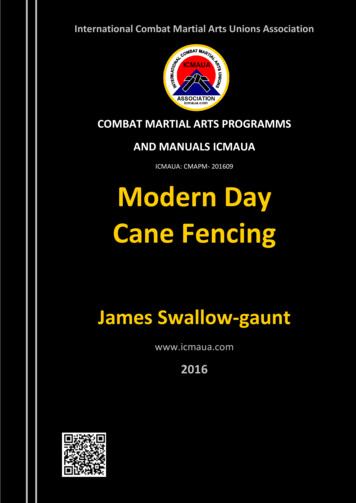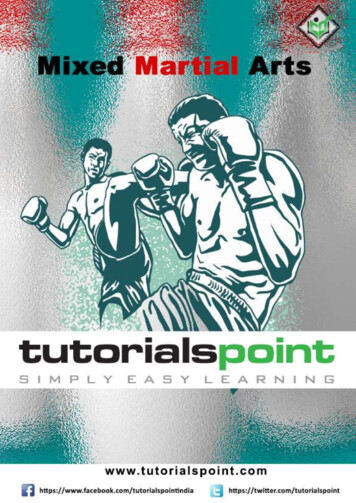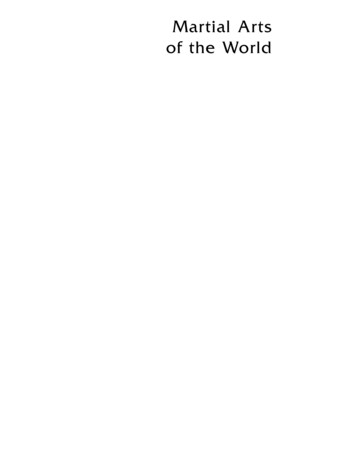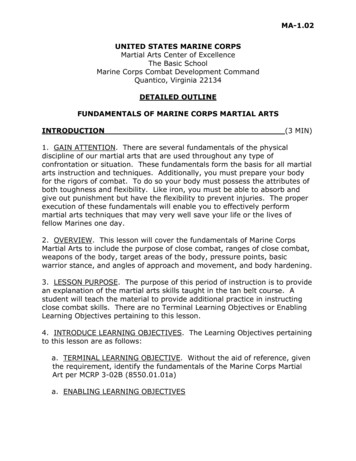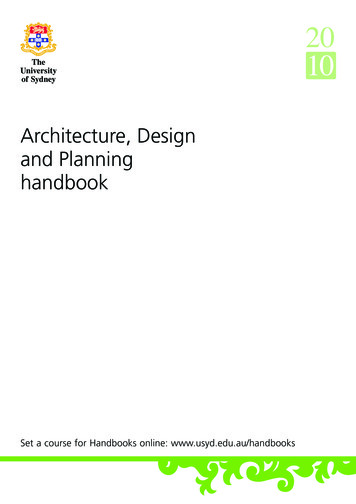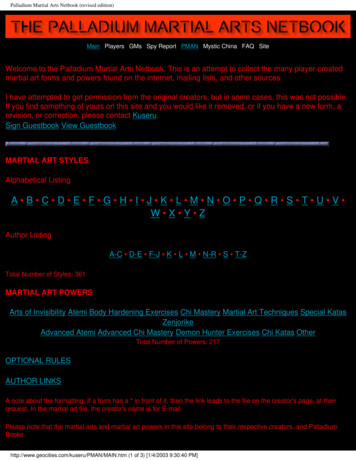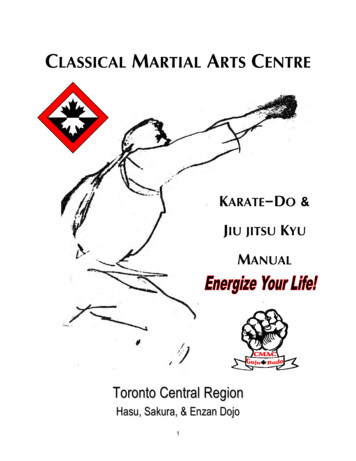
Transcription
CLASSICAL MARTIAL ARTS CENTREKARATE-DO &JIU JITSU KYUMANUALT o r o n to Ce n tr a l Re g i o nH a su , S a ku r a , & E n za n D o j o1
Creed of Karate-DoI face you with my empty handsWeapons, I have noneIf I should be forced to defend myself, my honour, my principles, my familyAs a matter of life or death, right or wrong,Then here are my weaponsMy empty hands.2
Tenets of Goju Ryu Karate-DoWe who are studying Karate-Do aspire to these virtues.1.2.3.4.5.We are proud to study the spirit of Goju.We shall practice courtesy.We shall be quick to seize opportunity.We shall always practice patience.We shall always keep the fighting spirit of Karate-Do.For the uncontrolled there is no wisdom,Nor for the uncontrolled is there power of concentration,For him without concentration there is no peace.GO JU -- YIN YANGTEACH THE OPPOSITES IN LIFEBe as hard as the world forces you to be.And be as soft as the world allows you to be.Sensei Chuck Merriman3
Table of ContentsCreed of Karate-Do . 2Tenets of Goju Ryu Karate-Do . 3Table of Contents . 4Basic History of Martial Arts . 8Origins of Karate-Do . 8Okinawa (The roots of Goju Ryu) . 8Chojun Miyagi . 9Gogen Yamaguchi .10O’Sensei Richard Kim .10Sensei Peter Urban .11Belt Tying Procedures . 1Kata Training . 2Kata Points . 2Kumite Training . 5Jiu Jitsu / Aikido Programme . 7Karate-Do Grading Requirements . 8Reading Requirements . 9WHITE BELT . 9The Student Manual . 9The Classical ManO’Sensei Richad Kim . 9YELLOW BELT . 9Karate-Do My Way of LifeThe Karate DojoGichin Funakoshi . 9Sensei Peter Urban . 9ORANGE BELT . 9Angry White PyjamasWeaponless WarriorRobert Twigger . 9O'Sensei Richard Kim . 9GREEN BELT . 9The Student Manual . 9Code of the SamuraiA. L. Sadler . 94
The Zen Way to the Martial ArtsMoving ZenTiesen Deshamaru . 9C. W. Nicol . 9Zen in the Martial ArtsJoe Hyams . 9BLUE BELT . 9The Book of 5 RingsM. Musashi . 9The Zen Way to the Martial ArtsZen in the Art of ArcheryTiesen Desaru . 9Eugene Herrigel . 9Zen Mind Beginner’s MindShunryu Suzuki . 9BROWN BELT . 9The Student Manual . 9The Chinatown DojoSensei Peter Urban . 9Tao of Jeet Kun DoBruce Lee . 9The Path to Liberation: The Fighting Spirit of JapanIntroduction to BuddhismHerman Kauz . 9D.T. Suzuki. 9Best Karate Kumite I & IINakayama . 9SHODAN . 9Review all books up to this level. . 9Zen Mind Beginner’s MindZen and the SamuraiShunryu Suzuki . 9D.T. Suzuki . 9A Man of ZenD.T. Suzuki . 9Tao te ChingLao Tsu . 9The Art of WarSun Tzu . 9Three Pillars of ZenThe CatRoshi Phillip Kaplean . 9Cogen Yamaguchi . 9Books You Should Read . 10Adult Karate-Do Kata Requirements . 11CMAC GO JU BUDO .11OTHER GO JU RYU .11OTHER RYU .11YAKU SOKU KUMITE / FUTARI NO KATA .115
White Belt .11Taikyoku Chudan .11Yellow Belt .11Orange Belt .11Green Belt .11Blue Belt .11Brown Belt .11Black Belt Sho Dan . Error! Bookmark not defined.Black Belt Ni Dan . Error! Bookmark not defined.Black Belt San Dan . Error! Bookmark not defined.Black Belt Yon Dan . Error! Bookmark not defined.Black Belt Go Dan & Up . Error! Bookmark not defined.Adult Jiu Jitsu Requirements . 13White Belt .13Yellow Belt .14Orange Belt .14Green Belt .14Blue Belt .14Brown Belt .14Books Studied . 16Grading Record . 17Seminar Record . 18Glossary of Terms . 19STANCES (DACHI) .19BLOCKS (UKE) .19PUNCHES (ZUKI).20STRIKES (UCHI).20KICKS (GERI) .20Yellow Belt Karate-Do Exam . 23Goals are Dreams with a Schedule, Deadline, and Time Table .236
Questions From the Classical Man .23Orange Belt Karate-Do Exam . 24Questions for the Karate Dojo .24Questions from Karate-Do My Way of Life .25Green Belt Karate-Do Exam. 26Blue Belt Karate-Do Exam . 27Brown Belt Karate-Do Exam . 28Black Belt Karate-Do Exam . 297
Basic History of Martial ArtsOrigins of Karate-DoKarate-Do owes its composition to diverse ancient fighting techniques such as Egyptianbare-handed fighting, Roman gladiatorial combat, Japanese sumo wrestling, Indian andPersian foot fighting, and the weaponless fighting found in Thailand, Malaysia,Cambodia, Laos, and Vietnam. The Chinese people were exposed to these differentmethods of fighting during their extensive military and economic contact with the abovecountries. The fighting styles were observed, analyzed, and utilized by the Chinese;and it is in China that all these styles came together and influenced the configuration ofch'uan fa; which is the Chinese tradition of pugilism and the forerunner of Karate-Do.The most prevalent school of thought traces the origins of ch'uan fa back to the 6thcentury mytho-historical figure, Bodhidharma, and considers him to be the patriarch ofZen and the Chinese Martial Arts. According to legend, Bodhidharma was born in Indiaduring the early 6th century to a warrior class known as the Kshatriaya. He traveledfrom India to the Songshan Mountains, in the Honan province of China, and foundedthe Shao Lin Temple.The monks at the Temple were weak and in poor condition and thus very vulnerable toattacks from bandits and muggers.Bodhidharma created ch'uan fa to help them improve physically. Bodhidharma taught18 postures, 2 sutra, and sitting meditation (zazen). The kata include exercises andbreathing techniques to foster physical health and strength which were modeled on themovements of animals i.e., the tiger, monkey, leopard, crane, and snake. The sutrawere developed to foster mental and spiritual growth. These kata, sutra, and zazen,formed the fundamentals of ch'uan fa, the precursor of Karate-Do.Okinawa (The roots of Goju Ryu)The roots of Goju Ryu Karate-Do canbe traced directly back to Okinawawhich was called Ryukyu until 1870.In 1872 this small island officiallybecame a prefecture of Japan.In 1340 the Ryukyu Dynastyestablished tributary links with theChinese Emperor of the Ming Dynasty,and until 1866 delegates were sentback and forth from each country.Many masters of Chinese Kempo wereamong the delegates from China, andthey taught their art to the Okinawannobility.The Okinawans sent ships filled withextremely valuable presents to the8
Chinese Emperor as tribute. To protect this precious cargo all the Okinawans on board(crew members and delegates) were well trained in Martial Arts. After paying tribute tothe Emperor, some of the Okinawan delegates furthered their training in China beforereturning home.In 1470 all weapons in Okinawa were banned and confiscated. This political move leddirectly to the development of two different fighting systems: Te, practiced by thenobility, is a form of empty hand combat; and Kobudo, developed by farmers andfishermen is a form of armed combat using simple tools as weapons. In both systems,training was conducted in strict secrecy.The different styles of Te (Naha -te, Tomari-te, and Shuri-te) were named after thevillages where they were practiced. Naha-te is the direct ancestor of Goju-Ryu KarateDo; Shuri-te developed into Shorinji-Ryu which in turn developed into many differentstyles (such as Wado Ryu and Shotokan Karate-Do). A combination of Goju Ryu andShorinji Ryu led to the development of Chito Ryu.Chojun MiyagiThe founder of Goju Ryu Karate-Do is Chojun Miyagi.He was born in Naha Okinawa on April 25th 1888, to anoble family.His birth name, Miyagusuku, waschanged to Miyagi by the Japanese. At the age of 14Miyagi began training under Arakaki, who introducedhim to his friend, the foremost Naha-te master, KanryoHigaonna; he was his Sensei's disciple for 15 years.In Fuzhou in Fukien Province, Miyagi studied ShaoLin Chuan and also Ba Gwa Chang (eight trigrampalm -- soft fist style). In 1908 he returned to Okinawa.Using his knowledge of Chinese Kempo he adaptedNaha-te to more fully reflect the hard and soft aspectsof Karate-Do -- the give and take required to besuccessful. He invented three important kata: Tensho,Gekisai Ichi, and Gekisai Ni.The word goju means hard and soft. Go is the Japanese word for hardness and ju isthe word for softness. The system is based on the oriental concept that all hardnessand stiffness is not good. At the same time all softness and too much gentleness is notgood. The two should complement each other. This combination gives Goju Ryu itsbeautiful, disciplined movements, filled with grace, flowing forms and strength. Actionsare sometimes extremely fast and other times slow and majestic. oju Ryu relies on anaggressive style of attack with emphasis on delivering blows hard but with easy effortand in rapid succession, manoeurving not only forwards and backwards but also fromside to side.9
Gogen YamaguchiYamaguchi Sensei was born January 20, 1909 inKagoshima, Japan. He heard of Goju Ryu Karate-Do andof the great Okinawan, Miyagi Chojun, while attendingRestsumeikan University in 1929. Curious about thesystem, Yamaguchi Sensei, (The Cat), wrote to MiyagiSensei and invited him to come to Japan.The meeting of the two proved to be fateful, not only forGoju Ryu but for all Karate-Do. Yamaguchi Senseiimmediately fell in love with the strange and intricatepatterns displayed by Miyagi.The hard and softapproach was for him. When Miyagi Chojun Sensei leftJapan to return to Okinawa he left behind him a welltrained and educated follower in Goju Ryu.In 1930, Masters succeeded in getting Karate-Doadmitted into the Butoku-Kai, (the official governmentheadquarters for the Japanese Martial Arts). That sameyear Goju Ryu headquarters were established in Tokyo next to the famous Giho KaiJudo Institute. In 1950 the headquarters of all Japanese Karate was relocated toTokyo. This led to an increase in the popularity and exposure of Goju Ryu.In 1936 Yamaguchi Sensei organized a Dojo that radically altered the development of KarateDo. He believed that the strict Okinawan brand of Karate-Do was too static and limited,and thus, developed Jiu Kumite which did not exist in the traditional system. Heblended the Okinawan Goju Ryu with yoga, and Shito elements and the Bushi (Samurai)tradition creating a typically Japanese style.The Second World War introduced Goju Ryu Karate-Do to servicemen who helpedspread it to different countries. In 1953, Miyagi Sensei passed away, leaving MeitokuYagi to succeed him in Okinawa and with Yamaguchi Sensei continuing his efforts inexpanding the art in Japan.O’Sensei Richard KimO'Sensei Richard Kim is considered by many to be one of the mostknowledgeable Martial Artists. Born in 1917, he began studyingMartial Arts at the age of 6. His training includes Karate-Do, Judo,Shorinji-Ryu, Kempo, Tai Chi, Ba Gwa, and Boxing under manynotable teachers. His vast experience in the Martial Arts hasbeen made available to others through his writings andteachings. His students include Peter Urban, Benny Allen, DonWarrener, and Wallace Platt.10
Sensei Peter UrbanSensei Peter Urban is a teacher, a writer, a . His specialty is the field of martialcombatives and their cognates, and he is consideredthe world's foremost authority on ychoanalysis of the Martial Arts). He is the head ofAmerican Goju Do.Sensei Urban began training in 1953 when he was 18years old. He had gone to Japan as a sailor in the USnavy and stayed for 8 years to study Karate-Do. SenseiUrban started studying in Yokohama with O'SenseiRichard Kim and then a year later trained with SenseiYamaguchi and Sensei Mas Oyama in Tokyo. Hereturned to the States and taught Karate-Do,introducing Goju Ryu to North America.In 1965 he founded his famous China Town Dojo, and established American Goju-Do.Sensei Urban believed that America should have its own endemic Karate-Do style, in muchthe same way that the Okinawans and Japanese have theirs. He developed an uniquelyAmerican style which includes the additions of the Kata Empi Ha and Urban Han. Hisstudents include Skipper Ingram, Chuck Merriman, Phil Maldonato, Johnny Cool, Al Gotay,Bob Dalgleish and Wallace Platt.When Sensei Urban recently turned sixty, he was quoted as saying: "Karate has beenvery, very good to me and on this day I celebrate that fact forever. The purpose ofKarate training is to walk with confidence in your old age. I walk with confidence. Istarted Karate as a very young child. That is why I walk with confidence today."Four Tools of Discipline:1. Delayed Gratification2. Take 100% responsibility for your actions3. Balance of mind, body, and spirit.4. Adhere to the TruthA KARATE-DO MASTERIS ONE WHO IS LIBERATED FROM FEAR11
Belt Tying Procedures (Click HERE for Online Video)Make sure that yourjacket ties have beenproperly secured first(1,2,3).123After you have foldedthe belt in half todetermine the center(4),placethecenterpoint at yournaval (5).45Crosseachendaround the back of yourbody (6) then continueto the front (7), placingthe end in your righthand over the one inyour left.67From there draw theoverlapping ends of thebelt up between thejacket and the belt (8)andcompletethesquare knot as shown;left over right (9,10).8910It is considered amatter of pride for theends of the belt to be ofequal length after theknot is neatly tied(11,12).11121
Kata TrainingThe Kata is a means of self perfectionThe kata, which is sometimes translated as form or pattern, allows you to practice yourcombinations at full power with imaginary opponents .It is said that, if by the time you reach black belt, you can do two kata, (and only one ofthem very well) your training is being maximized.The Karate-Do kata demands complete concentration and maximum effort from itspractitioner. Kata is more difficult than sparring because you are 100% in control ofthe action.The means used by masters to hand down their techniques over the ages hasbeen the kata. This fact in and of itself should give us reason to practice kata.The essence of Karate-Do is in the kata. Practice repeatedly and indefinitely.Kata Points1.Kata is a series of prearrangedmovements designed for fighting multipleopponents.2.Be aware of these six areas whentraining your forms: eyes, pace, breathing,technique, kime and kiai.3.Performed consistently, the kata willimprove your speed, balance, posture,contact, technique and co-ordination.4.Only Sensei, Senpai, or a designated blackbelt can show a kyu belt a new kata.5.Most forms have two kiai points usually seton the finishing techniques or killing blow.6.Most kata end by stepping away from youropponent. This symbolizes that you haveleft your opponent alive.7.All kata start with the right hand coveredsince the right hand is symbolic of strengthand therefore hidden so as not to offend theopponent.8.Visualize what you are doing when you dothe kata, this will help you to understand it better.2
9.Steps to follow when learning a kata:1. Learn the schematics of the form (the moves).2. Learn the proper pace of the form.3. Learn to do the form without thinking.4. Become one with the kata.10.If you have any questions about a kata you have been taught, ask your Sensei,Senpai, or designated instructor.11.All kata start and end with the heels on the embuson.12.The first and last steps of a kata are the most important.3
Bun Bu Ryo Do is the Way of the Pen & Sword in Accord 1/3 Austere Physical Training 1/3 Mental Assimilation 1/3 Protracted MeditationThe Three Phases of Training:41.Body Relaxed, Mind Tight2.Body Tight, Mind Relaxed3.Combination of 1 and 2
Kumite TrainingThe invention of freesparring, (Jiyu Kumite), byGogen Yamaguchi, is arelatively new addition toKarate-Do.Ippon Kumite teachesyou timing anddistancing.Sparring will help withyour distance, timing,and spontaneity anddevelopmentofselfdefenseabilities.Sparring in class is theclosest you can get to areal fight without injury to yourself or your opponent. A constant change of fightingpartners allows you to try your techniques in a partially controlled situation. The usualdistance between partners is 30-36 inches but this will vary depending on individuals.Points that will make you a better fighter:1. Get in the best physical shape possible.2. Have a calm mind when facing an opponent.3. Have an active body, keep moving when you face your opponent. (4) Seethrough your opponent's attacks.4. React as quickly as possible to your opponent's move.5. When you go in on your opponent, go in strong and with full conviction.6. Practice basic techniques and combinations repeatedly.7. After a foot sweep you must strike.8. It is not enough to hit with the body, you must hit with the mind and spirit.Should a kyu belt who is in charge of leading a class allow any type of fighting?No! He or she does not have the experience or expertise to conduct a sparring matchproperly.5
When sparring in the Dojo remember that there isabsolutely no head contact allowed
knowledgeable Martial Artists. Born in 1917, he began studying Martial Arts at the age of 6. His training includes Karate-Do, Judo, Shorinji-Ryu, Kempo, Tai Chi, Ba Gwa, and Boxing under many notable teachers. His vast experience in the Martial Arts has been made available to others through his writings and teachings.File Size: 1MBPage Count: 40
